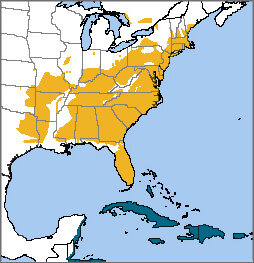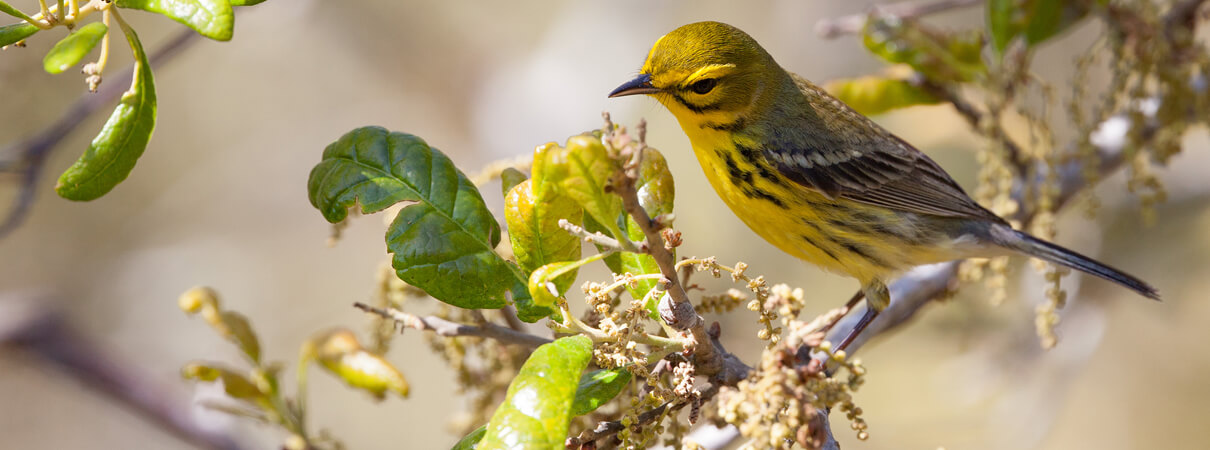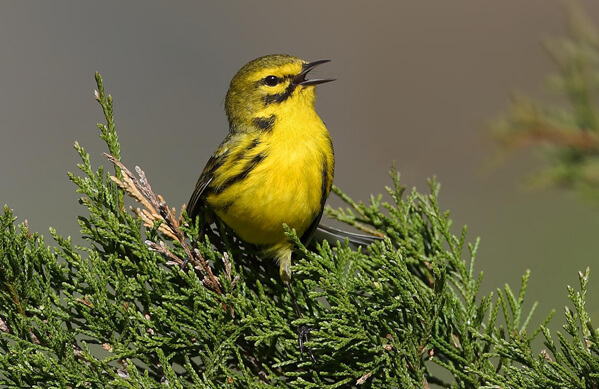 Contrary to its name, the Prairie Warbler is a bird of scrubby fields, clearcuts, and open woods, where it can be located by its buzzy, ascending song, tail-pumping habit, and black-streaked yellow plumage. This species has a bold facial pattern that gives it a “spectacled” appearance.
Contrary to its name, the Prairie Warbler is a bird of scrubby fields, clearcuts, and open woods, where it can be located by its buzzy, ascending song, tail-pumping habit, and black-streaked yellow plumage. This species has a bold facial pattern that gives it a “spectacled” appearance.
Like other early successional species such as Golden-winged and Kirtland's Warblers, Prairie Warbler numbers have declined due to habitat change. Along with other migratory birds, they also face threats ranging from collisions with glass to free-roaming cats.
The male Prairie Warbler sings two types of song, which are superficially similar but differ in volume and speed. One song, sung to the female during courtship and nesting, helps maintain the birds' pair bond and is demonstrated in the featured multimedia, above. The second type is sung at the boundaries of the male's territory to deter rivals . (Listen to this song type.)
A separate subspecies of Prairie Warbler is resident in Florida; these birds are slightly larger than migratory individuals and nest in mangroves.
Nesting on the Low-Down
Male Prairie Warblers on their territories can be quite conspicuous, as they sing and display from the tops of shrubs and young trees. Males return to the same area each year, and some will attract more than one mate to their territory, a breeding system known as polygyny.
Prairie Warbler nests are open cups of plant material and animal hair, built by the female low in a tree or shrub. This species raises one or two broods per season. Their nests are often parasitized by Brown-headed Cowbirds, which is also a problem for bird species ranging from Painted Bunting to Baird's Sparrow.
Sign up for ABC's eNews to learn how you can help protect birds
Young Prairie Warblers birds are fed by both parents and leave the nest at 8-11 days; each adult continues to care for part of the brood until the fledglings are completely independent.
Insectivore Antics
Like other neotropical species such as Kentucky, Blackpoll, and Cerulean Warblers, “Prairies” are insectivores, consuming large quantities of caterpillars, moths, beetles, ants, and flies, as well as spiders and millipedes. They forage near the ground, gleaning prey from leaves and branches while moving through the underbrush, tail pumping all the while.
Prairie Warblers also dart out to capture flying insects in mid-air, hang upside down from the tips of branches, and fly down to pluck prey from ground.

Prairie Warbler foraging in live oak. Photo by Anne Lindgren, Shutterstock
Reversing the Prairie Warbler Decline
The Prairie Warbler was included on the 2014 State of the Birds Watch List due to ongoing population declines.
The Central Hardwoods Joint Venture, of which ABC is a partner, is actively promoting healthy habitat for this species. This includes restoring more than 100,000 acres of woodlands since 2011 and reforesting recently abandoned farm fields to creating “glades”—sunny areas within the forest—that benefit many species.
“The shrubby parts of glades are where the Prairie Warblers breed,” says ABC's Jane Fitzgerald. “The scattered trees out on the edges of the glade are where you typically find Blue-winged Warblers. In the open canopies you'll see Scarlet Tanagers, Eastern Wood-Pewees, and Great Crested Flycatchers. If you're really lucky you might see a Bachman's Sparrow in the grasses and the wildflowers.” (Read more in our Winter 2013 issue of Bird Conservation.)
Other collaborative efforts, such as our Migratory Bird Program, are focusing on habitat conservation on the bird's wintering grounds in the Caribbean. And our advocacy programs, including Cats Indoors, Collisions, and Bird-Smart Wind, seek to reduce or remove some of the fatal obstacles faced by migrating Prairie Warblers and other neotropical birds.
Donate to support ABC's conservation mission!



















































